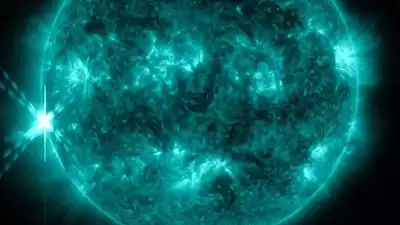Once more, the sun is ferociously vying for our attention by stretching its power with four simultaneous explosions.
Four solar flares simultaneously erupted across the sun’s visible surface at approximately 11:30 p.m. Eastern Time on Monday evening, according to video footage from NASA’s Solar Dynamics Observatory.
Solar flares have the power to propel solar material in the direction of Earth, resulting in geomagnetic storms within the planet’s atmosphere.
That may cause radio blackouts and GPS problems, or it may bring the stunning northern lights even farther south.
According to the National Oceanic and Atmospheric Administration’s Space Weather Prediction Centre, there was a radio blackout shortly after the flares; however, it was unclear from the agency’s report whether these events were related.
“I wouldn’t expect too much geomagnetic activity from these particular events, but these things are very difficult to forecast,” Mathew Owens, a University of Reading space physics professor, said to Business Insider via email. “We might get something of a glancing blow from one of them in a day or two.”
A request for comment was not immediately answered by the SWPC. As of Wednesday morning, the centre was not predicting any geomagnetic storms for the next three days, despite the fact that these eruptions were facing Earth.
An exceptionally sympathetic solar flare
The intense flares that occurred simultaneously most likely had a same underlying cause, a phenomenon called a “sympathetic solar flare.”
Sunspots and filaments can be connected by magnetic loops in the corona, the sun’s outermost region. These magnetic forces become unstable when one erupts, which has the potential to trigger more eruptions.
It refers to the “domino effect,” according to Owens, “where one region becomes unstable and sets off activity in a bunch of other locations, often at great distance.”
This solar flare qualifies as “super-sympathetic” since it often only involves two simultaneous explosions.
“This is a truly exciting occasion. Sympathetic flaring at four sites is quite uncommon,” physicist and University College London associate professor of space plasma Daniel Verscharen emailed BI.
The precise mechanism underlying sympathetic flares remains a mystery to scientists.
“A likely explanation is that one flare erupts and triggers a disturbance that travels through the solar corona,” Verscharen stated. “This disruption might be a shock wave that emanates from the sun’s first flare. This disturbance may cause another active zone to become unstable and erupt when it comes into contact with it.”
It’s sundown
Even though this event seems remarkable, unusual phenomena on the sun are occurring at precisely the appropriate time. At the pinnacle of its 11-year cycle, solar maximum, when our star turns hyperactive, is almost here.
For this reason, Earth has experienced a deluge of solar flares, eruptions, and coronal holes during the past year, which carry winds of plasma and magnetically charged particles.
Although scientists are unsure if the sun has reached solar maximum yet, if not, maximum is expected to happen during the next year.
Solar activity will subsequently begin to fall for years, resulting in less interference with radio and GPS signals on Earth and significantly fewer opportunities to witness the northern lights.
































